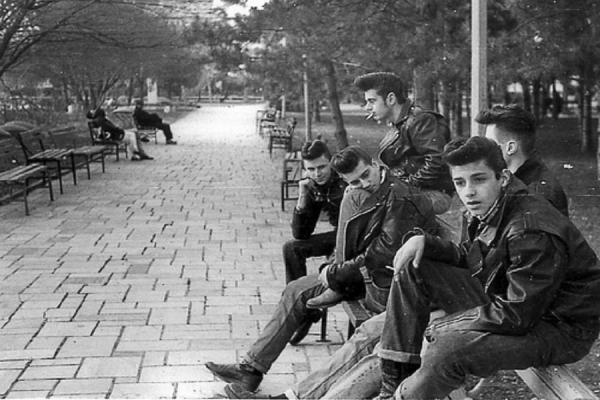ZANI- Chicago Stone Greasers – A History
Written by Mike ScottThroughout the 1950s until the early 1980s, Chicago's youth was divided into two cultures: the Greasers and the Hippies.
Greasers tried to hold on, or imitate the Greasers of the 1950s. The Hippies imitated the Hippies, or Freaks that most people remember from the 1970s before the disco era. Hippies were known for their parties; Greasers were known for fixing up old fast cars, drag racing, motorcycles, and joining gangs, though being in a gang wasn't a Greaser requirement.
They say that the Greaser era died when Doo Wop faded and President John F. Kennedy was killed in 1963, but there was an underground Greaser culture that existed in big cities around the country like Chicago, Brooklyn, The Bronx, Queens, Staten Island, Philadelphia, and the New Jersey Shore (Jersey City, Newark, and Perth Amboy). It wasn't uncommon to find Chicago Greaser gang members in the mid-1970s Doo Woping on their corners. Some of the Greasers evolved into the motorcycle clubs of the 60s and the Punk scene in the 1980s. The Greaser era never really died out. Today, the garage group Rockabilly Crews on the East Coast have brought the Greaser style back to the shore, though Greasers have always existed in New Jersey.
In Susan E. Hinton's novel/Movie "The Outsiders", she covered the period of the late sixties when there was a rivalry between the Greasers and Socs in Tulsa, Oklahoma. It has been reported that there were many Greasers still around at Tulsa's Will Roger's High School into the early 1970s. The movie did a great job of showing the two different groups fighting for position in society at a time when most of the country still had a large population of Greasers still around. Susan E. Hinton's follow-up novel/movie "Rumble Fish", did a fantastic job of showing the transition period where the Greaser's lifestyle was being replaced with the drug culture or the Hippie/Freak culture. Rumble Fish showed how the Greaser, or Greaser gang member, lost all loyalty to his friends and culture replacing it with drugs. The remaining Greasers in this period were considered out of style or a throwback to the fifties. To be accurate, the Greaser Culture disappeared at different times in different parts of the country, and in some areas never disappeared at all. 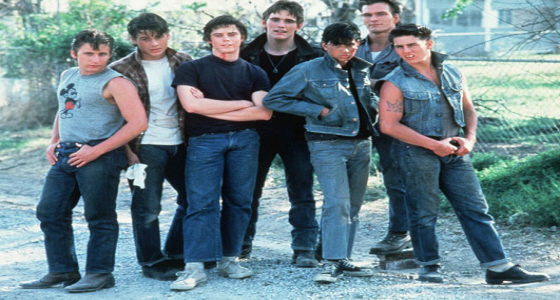
Sixties Greaser Clothing and Colours:
During the 1960s a lot of Greasers from the Southside would go to Maxwell Street at the weekends and find good bargains in leather and suede jackets, Italian knit shirts and baggie work pants. Back then Maxwell Street was called Jew Town and the rumour was if you were the first customer of the day in their store you could get just about anything for a great price because as the rumour went it was bad luck for them if they didn't make a sale to their first customer of the day. In Jew Town there were also good prices on shoes, the most popular were Stacy Adams and wingtips. After a while, the hottest item became the baggie work pants. On the Southside, the style started in Bridgeport with the Italian Greasers. You would see them wearing green work pants cuffed up and quilted work jackets and combat boots. The style caught on in other neighbourhoods and soon you would see white Greasers everywhere wearing baggies. In the early 60s, on the Southside none of the white gangs wore club sweaters. You would see a few gangs wearing jackets with their gang names on the back. In the latter part of the 60s, some white gangs started wearing club sweaters such as Centurians, LAs, Aristocrats, Cornell Dukes, and the Brothers of Brighton.
Sixties Southside Chicago Greaser stated:
Back in the sixties, we wore grey leather jackets and baggie greys, and combat boots. The blacks at Tilden High School used to call us "Greyboys" thinking we wouldn't like it.
The term "Stone Greasers" was borrowed from the Greaser gangs of Chicago who used to call themselves "Stone Greasers" because they could trace their legacy back to the gangs from the 50s. We felt that was a good term used to describe Greasers from all eras who live the Greaser lifestyle. This website was put together to honour all Greasers, from the originals of the 50s to the next generation Boppers of today, and for everyone who enjoys the lifestyle - we honour you
Two Will Roger's Greasers speak out:
Galvin, a Tulsa Greaser had this to say: I was/am/will always be a Greaser. My sister and Susan (Hinton) were friends, she and Ms. Parker who is still a teacher at Roger's, all hung out at the roller skating rink, the Rose Bowl, and the Admiral twin drive-in together. We were the guys at Will Roger's who had cars, smoked, and in my case had a leather jacket. Started back in 1947, and lasted until 1980. At that time the schools ended driving to school, smoking required you to be over 18, and with bussing the rich kids quit public schools and moved to private, making all the public schools here equally poor, wiping out the social disparity. Leather jackets, long hair, and rebellion were overtaken by gangs of mostly African Americans, and the white kids seemed to not hang out in groups anymore. Now it's CRIPS, and Bloods, Preppies, and Goths, Jocks, and Dweebs. None of them would dare to cross into another group. 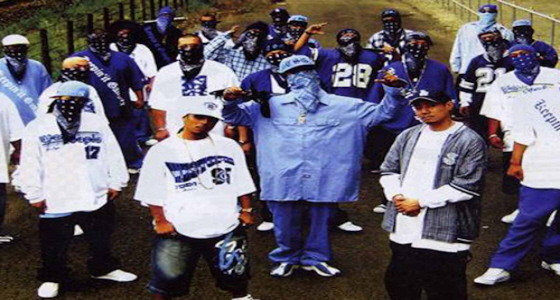
Gone are the days of loyalty:
Gone are the days when you might not know a kid, but if he was like you, both of you had the other's back. Pony-Boy, Soda-Pop, and the others have all grown up and moved on. Tex married Cherry his sweetheart from Edison (the rich kid school), and went on to be of all things a Cop. Pony-Boy died in 1968 in Vietnam, and Soda-Pop has his own Cycle shop just down the street from Roger's. They are grandpas and grandmas now. Susan (Hinton) still works with kids who want to be writers and is still seen hanging out by the park, but the fountain is gone now, like everything change is forever, and the moment's in time we share are best left to the writers to document.
Patricia, a Will Rogers Greaser had this to say: If you lived north of Admiral you were a "Greaser". South of Admiral you were a Soc! I graduated in 1972. I lived south of Pine Street and we were definitely a mixed crowd. The people living down the street from me were "Soc's at Roger's i.e. cheerleaders, etc. Myself I was a Roper Doper in the junior and senior years. We used to go to a drive-in at 18 and Sheridan to open up a big can of whoop azz on the Soc's at Hale....We partied at the boat house at Mohawk Park and got drunk every Friday night at the "library" restaurant on 11th Street. I have not been back to Tulsa for years now so I am sure things have changed but I am still a "Greaser" at heart. They can take those snotty "antisocial" (Socs) and keep them on the south side. But Roger's had PLENTY of "Soc's" believe me. My parents live near the Dairy Queen and middle school where the Outsiders was filmed in Owasso.
Bill 1970 Graduate: I graduated in 1970 from Roger's. There were Greasers, Soc's, Hippies, and of course the Jocks! The smoke hole was the place to go, if you were a sophomore they would make you climb the pole and I believe it was greased or you would get thrown out of the window in Art Class (faced East) into a sticker bush! They had just started desegregation of schools. I went to school with Susan Hinton's sister Beverly. Went to Burbank and Bell Junior High. Those were great years. The smoke for Greasers at Bell Junior High was at Sheridan Village underneath the ramp going to the second level. 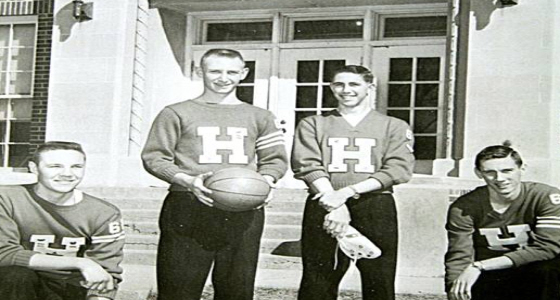
Stone Greaser Defined:
A Greaser from the 1960s/70s had this to say about "Stone Grease"
"The term 'Stone Greaser' didn't originate with any one club, or even in a club at all, and was never used to identify someone exclusively as a club member.
Seventies and Eighties Greasers:
Back in the sixties and seventies, 'stone' was a common ghettoism meaning 'extremely', or 'absolutely', something on those lines. 'Stone to the bone' was the common full version of the saying.
To say 'Stone Greaser', or the more common 'Stone Grease', simply meant that you were a hardcore Greaser."
Stone Greaser Grapevine:
In the 1970s, Chicago had an organization/underground newspaper called "Rising Up Angry" which would feature Gangs and Greasers in their "Stone Greaser Grapevine" section.
The "Stone Greaser Grapevine" would feature a Greaser gang in every issue. The "Stone Greaser Grapevine" was aimed at the Greaser subculture and would have a cartoon in the back usually involving a conflict between the Police and some Greasers. The organization "Rising Up Angry" tried to help out the gangs and form peace treaties between warring gangs.
In the cities, the Greaser subculture survived past the 1970s in places like Chicago, New York, and Tulsa where you had poor to working-class white neighbourhoods which did not experience "ethnic cleansing" until into the eighties and nineties. Cities like Detroit lost their Greaser neighborhoods in the late 1960s when the Whites moved out to the suburbs dispersing the Greaser subculture into communities where there wasn't a Greaser presence. "White Flight" did more damage to the Grease Culture than a change in style. Greasers still started car clubs, cruise nights, and sponsored fifties dances, but the big presence of Greasers in communities aimed at the Greaser lifestyle changed from leather to vinyl and blended into the suburban countryside. 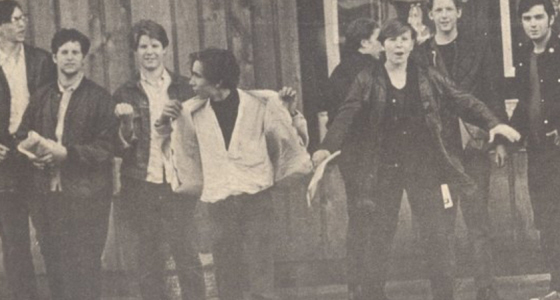
Greaser Demographics:
In the late 1940s through to the early 1960s, the majority of Greaser gangs and clubs tended to be made up of Italian, Irish and youth of European descent. After the Immigration and Nationality Act Amendments of 1965, immigration from European countries was greatly limited while immigration from third world countries increased. Demographics of inner-city working-class neighbourhoods changed dramatically during the sixties, seventies, eighties and nineties. At the same time poverty stricken families from the coal mining region - Appalachia - began to move north seeking a better life; therefore, in cities like New York, Chicago and Detroit Greaser gangs began to recruit more Appalachians as well as Polish, Russian and American Indian youth. In the late seventies through to the nineties, it wasn't uncommon to find entire gangs or sections made up of American Indian and Appalachian Greasers buried in pockets of the large cities.
Suburban Greasers:
When I moved to the suburbs and showed up at High School in my baggies and suedes... well let's put it this way. I stood out a bit.
We moved to the suburbs in 1974. My brother and I were Chicago Stone Greasers. We went to sign ourselves up for High School in Arlington Heights. We walked in through one of the smoking areas with greased hair wearing baggies, points, and suede and leather jackets, through a crowd of Jocks and Hippies. We stood out a little. When we were in the office filling out papers, outside the glass we saw a bunch of suburban Greasers clowning around trying to get our attention. We met about a dozen or so guys who hung out at some park. No one wore baggies; some had real leather jackets some plastic. What a bunch of clowns. Out of two dozen, maybe 3 or 4 were OK guys and one of them died young.
Vietnam Veteran Greasers:
White Flight" or "White Fright"?
Detroit Greaser/Veteran said this: I was home on leave during the '67 riots. My family lived on Belvidere between Charlevoix and Vernor. The neighbourhood went right down the tubes after that. I was overseas for most of '68, came home, and started witnessing the flight. Tried to talk my parents into moving then, but they and my older brother wouldn't budge. Came home in Aug '70 after the second tour, things had only gotten worse. By the time they finally moved out in '72 they were the only white family in a 20 block radius. Call it what you like, but their flight was inevitable. They rented the house out at first and then eventually sold it for next to nothing, just to be free of the taxes. This happened all over the city, people watched their neighbourhoods deteriorate, watched long-time friends move away, and watched their property, their life's work, valued to almost nothing.
This is what we so-called "baby killers" came home to. This plight and the spitters and jeering protesters at every airport. This is why the gang ranks expanded, and the streets got worse. These men, not boys, had no alternative and just didn't give a damn anymore. They struck back at society, the only way they had, for being convicted of the crime of serving their country. Myself, I was able to avoid this fate and got the family to move to the suburbs. Many other Caucasian veterans didn't. I can only imagine what it was like, the frustration and strife, for the minority of vets stuck in the inner city with nowhere to go, but stay and fight a different war. Hope that clarifies what I said about a turning point. 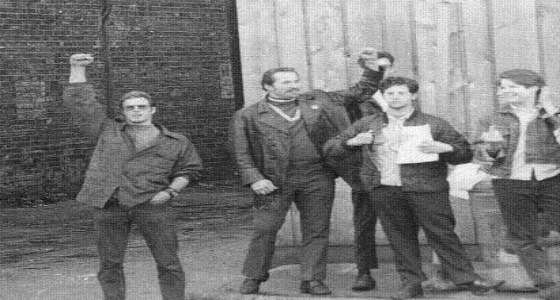
Used by Kind Permission of Mike Scott & http://www.stonegreasers.com
Mike Scott



